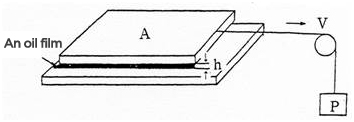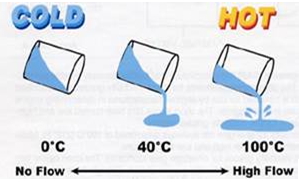Relation between base oils’ viscosity and temperature
1. What is viscosity?
Viscosity is the most important property governing the functions of a fluid and a measure of “sticky property” that represents the fluidity.
Viscosity is defined as a fluid’s internal resistance to flow. As shown in Figure below, if the upper slab is moved to the right side when a fluid is filled between two slabs, the magnitude of force needed to move the slab differs depending on the type of fluid. In other words, the fluid with high viscosity requires much more forces.

Absolute viscosity gives the absolute size of the degree of stickiness that resists the direction of the substance’s motion in the state of a flowing fluid. Kinematic viscosity is a relative indicator of the optimal degree of fluidity which indicates how well the substance flows, so the smaller the value is the better the fluidity is.
And the viscosity of lube base oils is defined by the molecular size as shown in Figure below; and the bigger the molecular size is, the higher the viscosity is. The size and structure of mineral-base oils are so diverse that viscosity is determined by the average molecular size. Meanwhile synthetic base oils have the same molecular structure and size.
In case of mineral base oils, the molecular size and structure change by external factors over the period of use, leading to a viscosity change in the end. But synthetic base oils are relatively very resistant to external factors because of the same molecular size and structure (high binding energy), resulting in slowing the viscosity change.

Generally the viscosity of lubricants means the kinematic viscosity expressed in cSt and the viscosity expressed in units other than cSt is as follows:
① cSt (Kinematic Viscosity)
Strokes refer to the kinematic viscosity expressed in C. G. S and one hundredth of it is expressed in centistroke (cSt). The measured temperatures are 40℃ and 100℃ according to the ISO (International Standard Organization) Viscosity Classification, which are used universally.
②°E (Engler Viscosity)
It is measured by dividing the flow time of sample oil of 200cc by the ratio of the flow time of water at 20℃. The measured temperatures are 20℃, 50℃, and 100℃ and mostly used in Europe.
③ SUS or SSU (Saybolt Universal Seconds Viscosity)
It is measured by dividing the flow time of sample oil of 60cc. The measured temperatures are 100℉, 130℉, and 210℉ and mostly used for the viscosity of base oils (in the U.S.).
For automotive lubricants, empirical SAE Viscosity Classification (SAE Standard J 300) is used.
The reason why the viscosity is called like SAE 10W-30 or SAE 40 is because the marks used when the viscosity was measured using the Saybolit viscometer are still used.
Then, let’s take a close look at the SUS viscosity that generally indicates the viscosity of base oils. For viscosity, it is required to measure SUS using the device below and put the second before alphabet N.

For instance, if the SUS is 150 seconds, it would be 150N; and if the SUS is 500 seconds, it would be 500N. Generally if N is placed after the number, the test was done at 40℃; and BS (Bright Stock) is placed after the number, the test was done at 100℃.
If the second measured in this way is converted according to the table below, it would become cSt (centi strokes), the unit of kinematic viscosity. The converted value corresponding to 500 second in the conversion table below is approximately 100 cSt.
2. Change by viscosity temperature
The viscosity of liquid usually changes according to temperature. Especially in case of lubricants (hydrocarbons), viscosity significantly differs depending on temperature variation.

[Viscosity Index]
Viscosity Index (VI) represents the relation between the viscosity of oils and temperature. The higher the temperature is, the lower the viscosity is. In contrast, the lower the temperature is, the higher the viscosity is. A high VI means that viscosity changed little by temperature variation.
VI indicates the stability of oils against temperature variation and the method of measurement is established based on experience. It is often used to determine or distinguish base oils (paraffin base oils have high VI while naphthene base oils have low VI). This is obtained through comparison and conversion on the assumption that the VI of base oils produced from Pennsylvania crude oil with excellent viscosity-temperature characteristics is 100 and the VI of base oils produced from Gulf Coast crude oil with poor viscosity-temperature characteristics is 0.

In general, if more paraffin is contained, VI is higher and if more naphthene is contained, low temperature characteristics is excellent.










